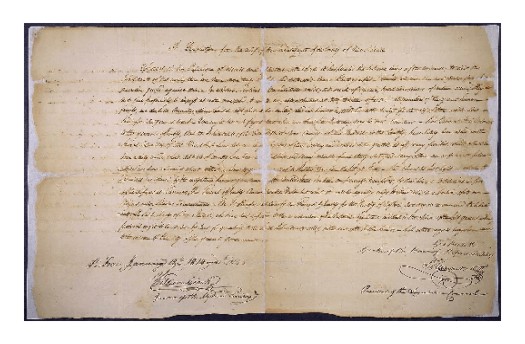More War of 1812 Timeline
T-Shirts/Souvenirs

War of 1812 History T-Shirts and Souvenirs from the official merchandise of America's Best History.
ABH Travel Tip

National Park Service sites and other national historic sites are made available for your enjoyment of the history and recreation opportunities there. Please take time to keep your parks clean and respect the historic treasures there.
Photo above: Flag from Fort McHenry during the War of 1812 that inspired the Star-Spangled Banner. Courtesy Library of Congress.
War of 1812 Timeline - Major Battles
It had only been twenty years since the first battle for independence had been fought and won over the British Empire with a new Constitution and the presidencies of Washington, Jefferson, and Adams in the books. But hostilities and disagreements between the fledgling nation, the United States, and Britain, had not abatted. By 1812, another war would be fought, for four more years, with the White House burned and strife from New England to Michigan, from Canada to the South. Many of these battles are not well known, even the burning of the new capital city is below the radar in american history for most, but this war, unlike the American Revolution, would solidify the nation as separate from Great Britain and capable of defending its territory. This time, the War of 1812 would hold its sovereignty. The battles listed below are considered the major battles of the War of 1812 by the staff of americasbesthistory.com, some protected by National Park Service sites, state parks, and others still to be protected.
-
1814
-
To the 1810's
Sponsor this page for $100 per year. Your banner or text ad can fill the space above.
Click here to Sponsor the page and how to reserve your ad.
-
Battle Timeline

1814
February 14, 1814 - USS Constition vs. HMS Pictou, Barbados
Troops: USA 1 ship; British 1 ship.
Casualties (Killed/Wounded/Missing): USA 0; British 1 ship.
USS Constitution attacks, then destroys the warship HMS Pictou as it escorts a merchant ship through the Atlantic. Merchant ship is confiscated by the Constitution.
March 30, 1814 - Battle of Lacolle Mill, Lower Canada
Troops: USA 4,000; British 500.
Casualties (Killed/Wounded/Missing): USA 267; British 61.
Significant American attack against Quebec garrision is repulsed when four hundred and twenty reinforcements and British ships arrive to assist eighty soldiers defending the garrison. British victory.
April 28, 1814 - USS Peacock vs. HMS Epervier, Cape Canaveral, Spanish Florida
Troops: USA 1 ship, 166 sailors; British 1 ship, 128 sailors.
Casualties: USA 2; British 23, 1 ship.
One sided cannonade leads to capture of British ship.
May 6, 1814 - Battle of Fort Oswego, New York
Troops: USA 467; British 1,150, 8 ships.
Casualties (Killed/Wounded/Missing): USA 267; British 61.
American forces abandon the fort under heavy attack, giving British the capture of supplies. They destroyed the fort before withdrawing.
May 29-30, 1814 - Battle of Big Sandy Creek, New York
Troops: USA 250, Indian Allies 125; British 153.
Casualties (Killed/Wounded/Missing): USA 2; British 43, additional 110 captured.
Short skirmish during attempt to bring shipbuilding supplies to the American base at Sackett's Harbor ends with American victory as soldiers and allies hidden attack stops British pursuit.
June 8-26, 1814 - Skirmishes at St. Leonard's Creek
Troops: USA 19 ships, 4,370 sailors; British 96 ships.
Casualties (Killed/Wounded/Missing): USA All ships lost; British 0.
Attempt by the Chesapeake Bay Flotilla, an American collection of vessels under privateer James Barney, to thrwart British attacks on the Chesapeake Bay. Initial attempts on the Chesapeake caused the flotilla, greatly outgunned, to seak refuge down the Patuxent River, then St. Leonard's Creek, which the British blockaded. On June 26, Barney broke out of the creek; the British burned St. Leonard's. By August 22, Barney ordered the destruction of the fleet as the British approached his position and marched his men to Washington.
July 3, 1814 - Capture of Fort Erie, Upper Canada
Troops: USA 4,500; British 137.
Casualties: USA, Under 10; British, All surrendered.
New invasion into Upper Canada by American forces begins against Fort Erie, which after only a few shots, is surrendered.
July 5, 1814 - Battle of Chippawa, Upper Canada
Troops: USA 3,500; British 2,100.
Casualties: USA 328; British 520, additional 15 captured.
American victories in their 1814 invasion into Upper Canada continues when British troops withdraw.
July 18, 1814 - Battle of Niagara Falls (Lundy's Lane), Upper Canada
Troops: USA 2,500; British 3,500.
Casualties: USA 853, including 79 captured; British 878, including 169 captured.
Indecisive battle with heavy casualties become tactical British victory as wounded forces of the United States are forced to withdraw from their invasion back to Fort Erie.
July 26 to August 4, 1814 - Battle of Mackinac Island, Michigan
Troops: USA 700, 5 ships; British 165, Indian Allies 150.
Casualties: USA 68; British/Allies 2.
British defend fort and island against attempt by American forces, sent from Fort Detroit, to retake Mackinac.
August 4 to September 21, 1814 - Siege of Fort Erie, Upper Canada
Troops: USA 2,500; British 3,000.
Casualties: USA 1,075, including 240 captured; British 1,551, including 748 captured.
Protracted engagement of siege and attack by British against Fort Erie is repulsed with heavy casualties. With winter approaching, the American forces eventually destroy and abandon the fort.
August 24, 1814 - Battle of Bladensburg, Maryland
Troops: USA 6,920; British 4,500.
Casualties: USA 50-77, 100-120 captured; British 249.
Tactical errors by American commanders lead to a disorganized retreat and costly defeat with President James Madison and many government officials present and almost captured. Considered one of the worst defeats in American military history with officials scattered throughout Maryland and Virginia. British troops march to Washington, burning the city the same day.
August 24-25, 1814 - Burning of Washington, D.C.
Troops: USA NA; British 4,250.
Casualties: USA 0; British 7.
British force led by General Robert Ross follow up the victory at Bladensburg by occupying Washington, burning the White House, Capitol building, including the Library of Congress, United States Treasury, and U.S. War Department. Large storm hit Washington the next day, putting out the fires, and the British left the city within twenty-six hours.
August 17 to September 6, 1814 - Gordon's Raid on the Potomac, Virginia
Troops: USA fort w/549 soldiers; British 6 ships.
Casualties: USA 30, 22 ships; British 45.
Expedition up the Potomac River by British Captain James Gordon meant as a diversion to main attack on Washington up the Patuxent River. Raids ends in occupation of Alexandria and American abandonment of Fort Washington, although delays in the movement caused this to occur after the burning of Washington.
September 1, 1814 - USS Wasp vs. HMS Avon, English Channel
Troops: USA 1 ship, 173 sailors; British 1 ship, 121 sailors.
Casualties: USA 3; British 39, 1 ship.
USS Wasp defeats HMS Avon in the English Channel, departing area as other English ships appear. HMS Avon sinks after battle.
September 6-11, 1814 - Battle of Lake Champlain, New York
Troops: USA 3,400, 14 ships; British 14,000, 15 ships.
Casualties: USA 220; British 388, 317 captured, four ships captured.
British army and navy attack New York town of Plattsburg, but are defeated after a hard fight. Ended British attempts to invade northern United States as peace negotiations begin in Ghent, Netherlands.
September 12-15, 1814 - Attack on Baltimore, Maryland
Troops: USA 11,000; British 5,500, 19 ships.
Casualties: USA 191, 50 captured; British 322-342.
Initial battle, September 12, five miles south of Baltimore at North Point inflicts casualties on British and delays their advance. Inner defenses at Hampstead Hill retain strength against British land invasion, as well as an initial attempt to take Fort McHenry by land. American victory; British withdraw.
September 13-14, 1814 - Bombardment of Fort McHenry
Troops: USA 1,000; British 19 ships.
Casualties: USA 28; British 1 ship captured.
Bombardment of Fort McHenry for twenty-five hours fails as the defense of Baltimore, including sinking of twenty-two ships in the channel to prevent their passing. Star-Spangled Banner written by Francis Scott Key from a truce ship in the river, inspired by the flag that flew over the fort during the battle.
September 14-16, 1814 - Battle of Fort Bowyer, Mobile Bay
Troops: USA 160; British 60, Indian Allies 60, 4 ships.
Casualties: USA 9; British/Allies 69, 1 ship, 1 ship severely damaged.
Attempt by British to capture the fort and make passage to Mobile by land, September 14, and sea, September 15, fails. Defeat leads British to attack New Orleans first instead of Mobile.
October 19, 1814 - Battle of Cook's Mills, Upper Canada
Troops: USA 1,200; British 750.
Casualties: USA 67; British 36.
Attempt by American forces to destroy grain and supplies succeeds when British forces retreat.
November 6, 1814 - Battle of Macolm's Mills, Upper Canada
Troops: USA 750; British 550.
Casualties: USA 7; British 27. 126 captured.
Last major battle of the War of 1812 in Canada occurs within the series of McArthur's Raids from Fort Detroit. American victory.
November 7-9, 1814 - Battle of Pensacola, Spanish Florida
Troops: USA 4,000; British/Spain/Creek Indians 600 plus.
Casualties: USA 18; British/Allies 15.
Jackson's battle in the Creek War coupled by a presence of the British in Pensacola from August 23 cause Jackson to move against the forts of Pensacola and challenge Spain's neutrality in the War of 1812. Initial demands by Spanish to surrender are eventually agreed upon and the British withdraw from Pensacola.
December 14, 1814 - Battle of Lake Borgne, Louisiana
Troops: USA 7 ships; British 42 ships.
Casualties: USA 41, 86 captured, 6 ships captured, 1 scuttled; British 94, 2 ships.
British win control of the lakes after two hour battle against outmanned American forces. Allows attack on New Orleans to commence nine days later.
December 23, 1814 - Battle at the Villare Plantation, Louisiana
Troops: USA 2,131; British 1,800.
Casualties: USA 213; British 277.
Night attack by Jackson's forces against British camp south of New Orleans in first engagement of that battle ends in tactical British win, maintaining their position, but is often credited with saving the Battle of New Orleans by demonstrating the force of the American troops, allowing time to construct defenses, and causing caution by British commanders.
Note: Photo above: Lady Liberty and the flag, Currier and Ives, circa 1856-1907. Image courtesy Library of Congress. Casualty and troop strength numbers from Wikipedia Commons via various sources.
History Photo Bomb

Resolution for federal aid from the Missouri Territory during the time of the New Madrid earthquakes in 1811-12. Courtesy National Archives.
About
America's Best History where we take a look at the timeline of American History and the historic sites and national parks that hold that history within their lands.
Photos courtesy of the Library of Congress, National Archives, National Park Service, americasbesthistory.com & its licensors.
- Contact Us
- About
- © 2021 Americasbesthistory.com.
Template by w3layouts.


